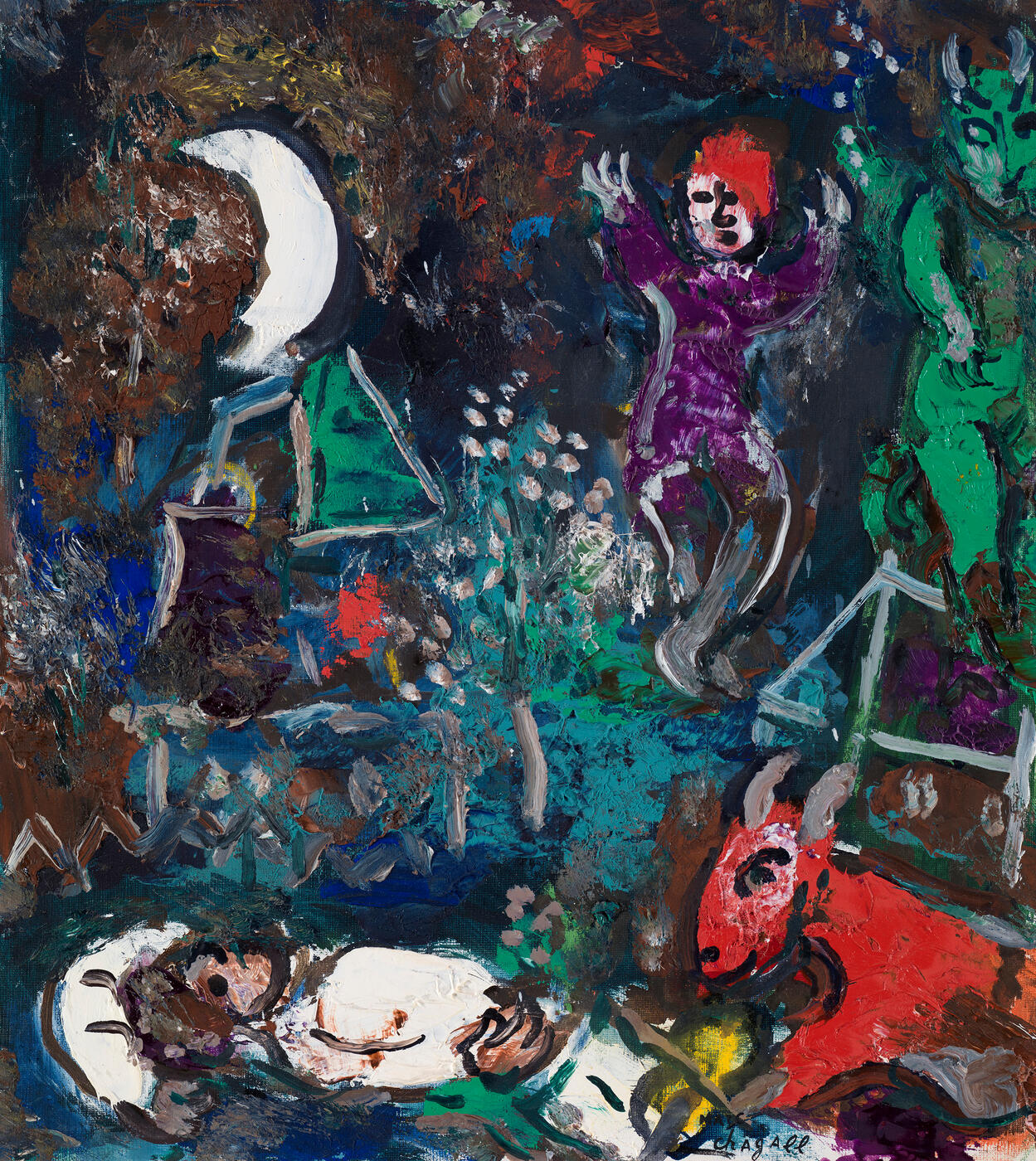3 June 2015 Russian Art Auctions
3 June 2015

§ 23. CHAGALL, MARC (1887-1985)
Le songe, stamped with the artist's signature.
Oil on canvasboard, laid on board, 30 by 27 cm.
150,000-200,000 GBP
Executed c. 1965.
Provenance: Impressionist and Modern Art, Christie’s London, 22 June 2005, lot 218.
Private collection, Lithuania.
Authenticity certificate from the Comité Marc Chagall.
Exhibited: Marc Chagall, Takashimaya Art Gallery, Osaka, Kyoto, Yokohama, Tokyo, 8 March–25 June 2012.
Marc Chagall, Prefectural Museum, Okayama; Prefectural Museum, Gifu, 13 July–28 October 2012.
Hello Paris! The Path of Litvak Artists, M. Žilinskas Art Gallery, Kaunas, Lithuania, 30 January–13 April 2014.
Colours and Forms of France, Vilna Gaon Jewish State Museum, Vilnius, Lithuania, 5 August–28 September 2014.
Literature: Exhibition catalogue, Marc Chagall, Tokyo, Takashimaya Art Gallery, 2012, p. 38, No. 21, illustrated.
Exhibition catalogue, Marc Chagall, Prefectural Museum, 2012, p. 60, No. 34, illustrated.
Exhibition catalogue, V. Gradinskaite, Hello Paris! The Path of Litvak Artists, Vilnius, Lewben Art Foundation, 2014, p. 33, illustrated.
Marc Chagall painted Le songe (The Dream) in 1965 and it is without doubt a continuation of the artist’s dominant pictorial topic. The whimsical combination of fantastic, dreamlike images with the simultaneous attention to the details of everyday life had become Chagall’s calling card as early as 1910. From then, and over the course of a
long life, during which his manner of painting only changed to an insignificant extent and his creative impulse never flagged for a minute, the artist created an impressive oeuvre of dream visions that encompass a whole stratum of European Judaeo-Christian culture, from Jacob’s Dream to A Midsummer Night’s Dream.
Chagall always mixed dreams and reality together, and essentially any mundane scene he commits to canvas – no matter how simple – acquires a dreamlike character. The viewer encounters, as it were, a complex puzzle, and one which is unlikely to have an
accurate and unambiguous solution.
Thus, in Le songe fragments, episodes, characters from rustic life and the bestiary of folklore are assembled into a single image, and together they make up a certain element of village or small-town existence – of the kind seen in Nikolai Gogol’s Evenings on a Farm near Dikanka – or by someone living deep in the pale of Southern Russian settlements. The details are all combined with each other in an arbitrary fashion. The figure of a peasant asleep on the grass in the foreground merges into the red profile of a cow playing the fiddle. Soaring above them in the night sky and their equal in grandeur are a green demon, a character in a red cap with arms held aloft, and the bright sickle of the moon. The earthly and heavenly planes are held together through the rural landscape discernible in the picture: little houses, a fence and a tree in blossom. All this is painted in a linear system which appears to encircle the earth, expand the space and create an atmosphere of a mythological universe, in which the individual character merges into a sort of overall symbolic entity and where the freedom for phenomena of differing orders is allowed to coexist.
At the same time, Chagall’s painting, whilst created in a post-Freudian artistic context,
is far from the attempts of contemporary Surrealist artists to remodel irrational principles
drawn from the subconscious. It may be said that, similarly to Surrealist images, Chagall’s imagery arises from dreams. However, these are not simply scraps cut from
the private reveries or reminiscences of an individual – always standing behind them
are the collective daydreams of an entire people, a joyous and noble Hasidic perception
of being, with its centuries-old artistic tradition. As Chagall himself puts it, “Art cannot be real without a pinch of the unreal in it. I have always felt that beauty is in the inverse. I don’t know how to explain this to you... Recall what our planet looks like. We float in space and do not fall. What is this if not a dream? I don’t know... This is why my characters soared heavenward long before the cosmonauts...”
Notes on symbols:
* Indicates 5% Import Duty Charge applies.
Ω Indicates 20% Import Duty Charge applies.
§ Indicates Artist's Resale Right applies.
† Indicates Standard VAT scheme applies, and the rate of 20% VAT will be charged on both hammer price and premium.